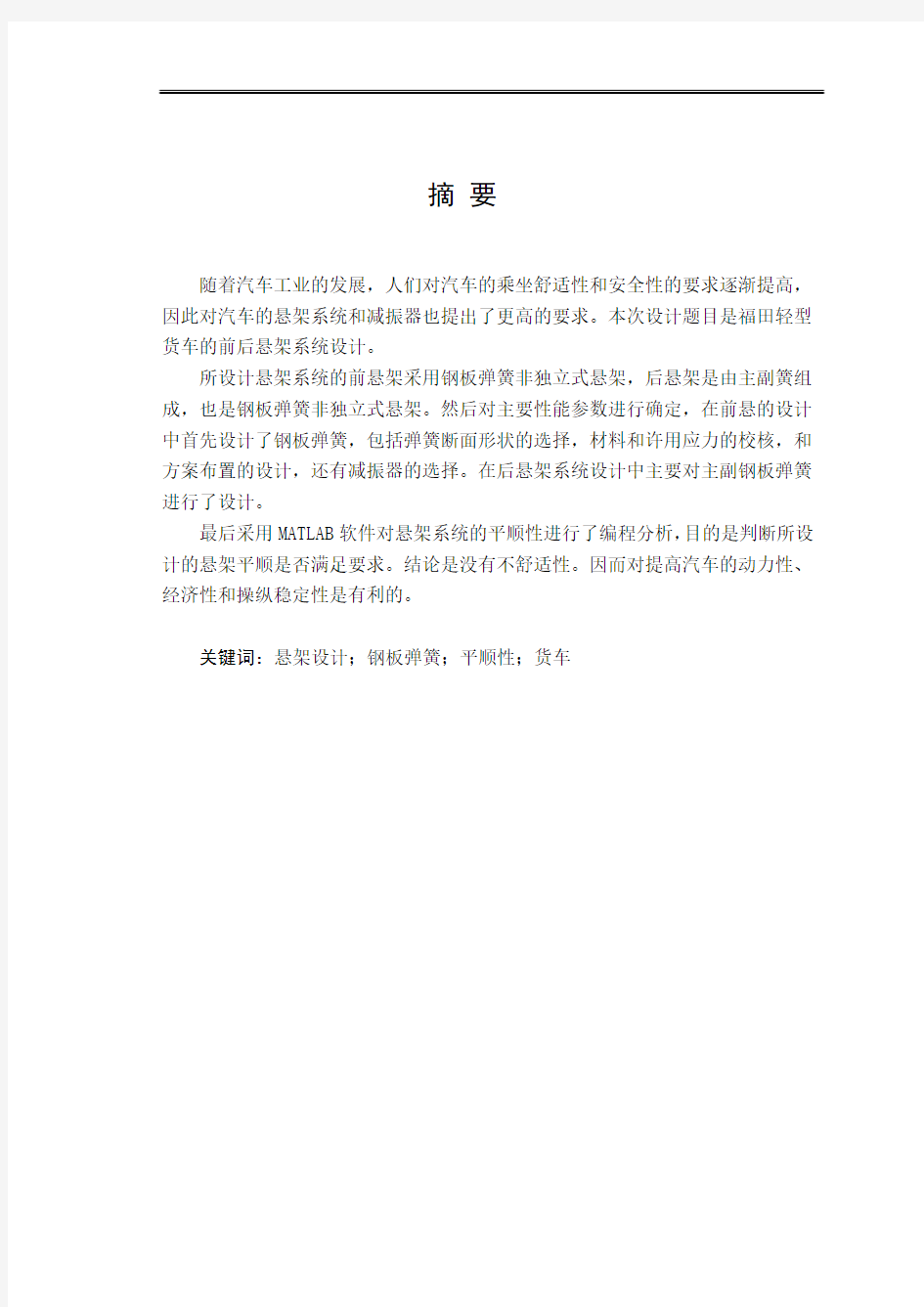福田轻型货车悬架系统毕业设计

- 1、下载文档前请自行甄别文档内容的完整性,平台不提供额外的编辑、内容补充、找答案等附加服务。
- 2、"仅部分预览"的文档,不可在线预览部分如存在完整性等问题,可反馈申请退款(可完整预览的文档不适用该条件!)。
- 3、如文档侵犯您的权益,请联系客服反馈,我们会尽快为您处理(人工客服工作时间:9:00-18:30)。
摘要
随着汽车工业的发展,人们对汽车的乘坐舒适性和安全性的要求逐渐提高,因此对汽车的悬架系统和减振器也提出了更高的要求。本次设计题目是福田轻型货车的前后悬架系统设计。
所设计悬架系统的前悬架采用钢板弹簧非独立式悬架,后悬架是由主副簧组成,也是钢板弹簧非独立式悬架。然后对主要性能参数进行确定,在前悬的设计中首先设计了钢板弹簧,包括弹簧断面形状的选择,材料和许用应力的校核,和方案布置的设计,还有减振器的选择。在后悬架系统设计中主要对主副钢板弹簧进行了设计。
最后采用MATLAB软件对悬架系统的平顺性进行了编程分析,目的是判断所设计的悬架平顺是否满足要求。结论是没有不舒适性。因而对提高汽车的动力性、经济性和操纵稳定性是有利的。
关键词:悬架设计;钢板弹簧;平顺性;货车
Abstract
With the development of the Automobile industry, people have been promoting the requirement for the safety and ride comfort quality of the vehicle. As a result, there is a higher demand on the suspension and the shock absorber system of the vehicle. The title of this thesis is the design of front and rear suspension systems of Fukudal truck.
The front suspension system is the leaf spring, dependent suspension. The rear suspension system consists of the main spring and the helper spring and it is also the leaf spring, dependent suspension. In the procedure of the design we made certain the structural style of the suspension system in the first, then we made certain the main parameters. In the design of the front suspension we designed the leaf spring firstly, including the selection of section shape of leaf spring, material and allowable stress and the design of scheme, moreover the design of shock absorber. In the design of rear suspension we carried out the design of the main spring and the helper spring.
In the final design stage, the MATLAB software is used to analyze the ride comfort of the suspension system by programming. The aim is whether suspension ride quality meets to the performance requirement. The results indicate that there is no uncomfortableness for the car on road. Therefore, it is helpful for the dynamical, economical and handling performances of the vehicle.
Key words: Suspension Design; Leaf spring; Ride Comfort; Truck
目录
第1章绪论 (1)
第2章悬架系统的结构与分析 (3)
2.1 悬架的功能和组成 (3)
2.2 汽车悬架的分类 (3)
2.3 悬架的设计要求 (4)
2.4 悬架主要参数 (4)
2.4.1 悬架的静挠度
f及刚度c (5)
c
2.4.2 悬架的动挠度
f (5)
d
2.4.3 悬架弹性特性 (5)
2.4.4 悬架侧倾角刚度及其在前、后轴的分配 (7)
2.4.5 钢板弹簧结构 (7)
第3章前后悬架系统的设计 (8)
3.1前悬架系统设计 (8)
3.1.1钢板弹簧的设计 (8)
3.1.2.钢板弹簧的验算 (9)
3.2后悬架系统设计 (12)
3.2.1主、副钢板弹簧结构参数 (12)
3.2.2钢板弹簧的验算 (14)
第4章减振器设计 (15)
4.1减振器分类 (16)
4.2前后悬架减振器计算 (16)
4.2.1相对阻尼系数和阻尼系数 (16)
4.2.2最大卸荷力 (17)
4.2.3工作缸直径 (17)
第5章平顺性分析和编程 (18)
5.1平顺性的概念 (19)
5.2平顺性的评价方法 (19)
5.3平顺性的分析 (20)
第6章结论 (24)
参考文献 (25)
致谢 (26)
附录Ⅰ:程序 (27)
附录Ⅱ:外文资料 (30)
附录Ⅲ:中文翻译 (32)
